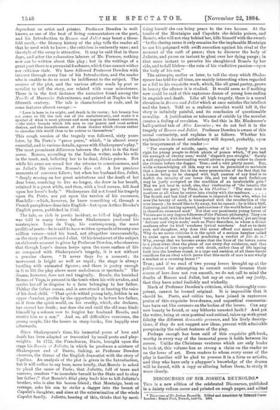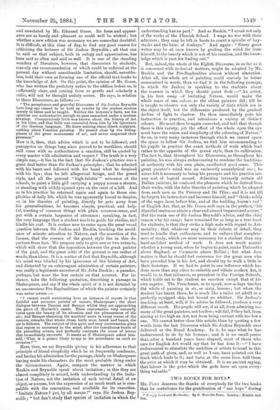DISCOURSES OF SIR JOSHUA REYNOLDS.* TIIIS is a new edition
of the celebrated Discourses, published in a dainty vellum cover and printed on rough paper, and edited • Discourses of Sir Joshua Reynolds. Edited and Annotated by Edmund Gesso London : Regan Paul, Trench, and Co. 1884.
and annotated by Mr. Edmund Goose. Its form and appear- ance are as handy and pleasant as could well be wished ; but whether a new edition was necessary we are somewhat doubtful. It is difficult, at this time of day, to find any good reason for criticising the lectures of Sir Joshua Reynolds ; all that can be said on that subject, both in eulogy and appreciation, has been said so often and said so well. It is one of the standing wonders of literature, however, that discourses to students, scarcely one recommendation of which could be enforced at the present day without considerable limitation, should, neverthe- less, hold their own as forming one of the official text-books to the knowledge of Art. On this point, the opinion of Mr. Gosse, who has written the prefatory notice to the edition before us, is sufficiently clear, and coming from so gentle and scholarly a critic, will not be thought unduly severe. He says, in relation to these Discourses, as follows :—
"The perspicuous and graceful Discourses of Sir Joshua Reynolds have long ago ceased to be held as oracles by the student anxious merely to listen and be taught. Neither the lecturer's facts, nor his opinions are authoritative enough to pass unscathed under a modern scrutiny. Comparatively little was known about the history of Art in his time, and that little was concealed from him by his ignorance of the German language. He knew nothing about Greek sculpture, nothing about Venetian painting. He passed close by the hiding- places of the great monuments of art, and never suspected their presence."
How is it, then, that advice which is not to be followed, and panegyrics on things long since proved to be worthless, should still come with so authoritative a sanction, still be quoted by every master with admiration and respect The truth is a very simple one,—it lies in the fact that Sir Joshua's practice was a great deal better than Sir Joshua's principles ; that he admired with his heart and followed with his hand what he despised with his lips ; that he left allegorical design, and the grand style, and all the general " high-falutin' " nonsense of the schools, to paint a little girl carrying a puppy across a stream, or standing with widely-opened eyes on the crest of a hill. And as in his practice he returned again and again to those sim- plicities of daily life, which he was apparently bound to despise, so in his theories of painting, directly he gets away from his generalisations, he becomes simple, practical, and help- ful, treating of common things with plain common-sense, and yet with a certain largeness of utterance ; speaking, in fact, the very language that a student needs to guide his studies, and kindle his zeal. It is useless now to enter upon the great vexed question between Sir Joshua and Ruskin, touching the avoid- ance of minute attention to Nature, and the assertion of the former, that the essence of the grand style lies in this de- parture from fact. We propose only to give one or two extracts, which will show that the opposition between the great painter of the past, and the great critic of the present is one rather of words, than ideas. It is a matter of fact that Reynolds, although his mind was blinded by his ignorance of the history of Art, and distorted by an extravagant admiration of certain painters, was really a legitimate ancestor of Mr. John Ruskin ; a paradox, perhaps, but none the less certain on that account. For in- stance, take the following quotation, describing a passage in Shakespeare, and say if the whole spirit of it is not dictated by an unconscious Pre-Raphaelitism of which the painter certainly was never aware :-
"I cannot avoid mentioning here an instance of repose in that faithful and accurate painter of nature, Shakespeare ; the short dialogue between Duncan and Banquo whilst they are approaching the gates of Macbeth's castle. Their conversation very naturally turns upon the beauty of its situation and the pleasantness of the air; and Banqao observing the martlets' nests in every recess of the cornice, remarks that where those birds most breed and haunt, the air is delicate. The subject of this quiet and easy conversation gives that repose so necessary to the mind, after the tumultuous bustle of the preceding scenes, and perfectly contrasts the scene of horror that immediately succeeds. It seems as if Shakespeare asked him- self, 'What is a prince likely to say to his attendants on such an occasion ?'"
Here, then, we see Reynolds giving in his adherence to that principle of literal simplicity which he so frequently condemns, and basing his admiration for the passage, chiefly on Shakespeare having made his characters do the most probable thing under the circumstances. Again, compare the manner in which Ruskin and Reynolds speak about imitation ; in this they are almost completely in accord, both understanding by the imita- tion of Nature, not the imitation of each trivial detail of an object, or a scene, but the expression of as much truth as is com- patible with the conception, and available for its execution.
"Imitate Nature ? yes, by all means !" says Sir Joshua Rey- nolds; "but don't study that species of imitation in which the
understanding has no part." And so Ruskin, "I speak not only of the works of the Flemish School. I wage no war with their admirers ; they may be left in haste to count a spicithe of hay- stacks and the hairs of donkeys." And again : "Every great writer may be at once known by guiding the mind far from himself, to the beauty which is not of his creation, and the know- ledge which is past his finding out."
But, indeed, the whole of the Eighth Discourse, in so far as it is concerned with technical matters, might be adopted by Mr. Ruskin and the Pre-Raphaelites almost without alteration. After all, the whole art of painting could scarcely be better summarised in words, than we find it in the following passage, in which Sir Joshua is speaking to the students about the manner in which they should paint flesh :—" An artist, in his first essay -of imitating Nature, would make the whole mass of one colour, as the oldest painters did ; till he is taught to observe not only the variety of tints which are in the object itself, but the differences produced by the gradual decline of light to shadow. He then immediately puts his instruction in practice, and introduces a variety of distinct colours. He must then be again corrected, and told that though there is this variety, yet the effect of the whole upon the eye must have the union and simplicity of the colouring of Nature." So on, in very many instances through which we cannot spare the space to follow Sir Joshua, we find him recommending to his pupils in practice the exact methods of work which lead rather to the opposite of the grand style, than its cultivation. The fact is, that throughout his Discourses, as throughout his painting, he was always endeavouring to combine the traditions of authority with his own plain, unaffected good sense. This great painter's mind was an eminently unanalytical one ; he never felt it necessary to bring his precepts and his practice into any sort of logical accord. Admiring intensely certain old Italian painters, he confused the pleasure which be derived front their works, with the false theories of painting which he adopted from such men as Da Fresnoy and De Piles ; and it is not till he forgets his instructors and becomes himself, and "thinks solely of the eager faces before him, and of the budding Aaron's rod" of English Art, that, as Mr. Gosse well says in the preface," his dignified sentences attain a clear and almost impassioned accent." But the main use of Sir Joshua Reynold's advice, and the chief reason why his essays have remained for so long as a text-book for students, is that they strike a high note with regard to Art- morality; that whatever may be their defects of detail, they tend to kindle that enthusiasm, and to enforce that complete- ness of study, which are more necessary for a student than any hard-and-fast method of work. It does not much matter whether a young man, when he begins to paint, ranks Tintoretto above Raphael, or Carpaccio above Bellini ; but what does matter is that he should feel reverence for the great men who have preceded him in his Art, and should try to walk a little in their footsteps. If we had to point to one influence which has done more than any other to enfeeble and vitiate modern Art, it would be to that influence, so prevalent in the Foreign Schools, which holds out to the student no sanction except that of his own caprice. The Frenchman, so to speak, now-a-days teaches the' whole of painting in six, or sixty, lessons ; but when the student has learnt these, he is much like a sailor set adrift in a perfectly equipped ship, but bound no whither. Sir Joshua's teaching, at least, will, if its advice be followed, produce a very different result. His pupils will err, if at all, from admiring too many of the great painters, not too few ; will fail, if they fail, from aiming at too high an Art, not from being content with too low a one. We cannot better close this article, than by quoting a few words from the last Discourse which Sir Joshua Reynolds ever delivered at the Royal Academy. In it, be says what he has endeavoured to do by his lectures ; and it is no small praise that, after a hundred years have elapsed, most of those who care for English Art would say that he has done it :—" I have endeavoured to stimulate the ambition of artists to tread in this great path of glory, and, as well as I can, have pointed out the track which leads to it; and have, at the same time, told them the price at which it may be obtained. It is an ancient saying, that labour is the price which the gods have set upon every- thing valuable."



































 Previous page
Previous page